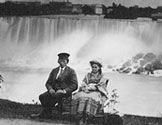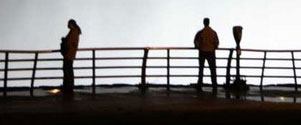

|
||||||||||||||||||||||||||||||||||||||||||
|
| ||||||||||||||||||||||||||||||||||||||||||
 |
 |
 |
 |
 J.N.B. Hewitt As Niagara County celebrates its Bicentennial, it is fitting to honor a man who traced his heritage back to its Quadra-centennial. Noted Tuscarora linguist and ethnologist, J.N.B. Hewitt, of mixed cultural descent, was proud of both his Indian and white heritage and spent most of his adult life studying the language, culture and history of the Iroquois and other Native Americans. Hewitt became acclaimed as a world authority on Indian lore and spoke fluently in six Iroquoian languages. John Napoleon Brinton Hewitt was born in 1857 on the Tuscarora Reservation in Niagara County. Hewitt’s father, Dr. David Brainard Hewitt was an orphan adopted by the Tuscaroras and raised as an Indian. Hewitt’s mother Harriet was Tuscarora, her maiden name was Printup, probably a descendant of William Printup, Jr., interpreter for Sir William Johnson. She was the daughter of Chief Jonathan Printup and his wife, Eliza Mt Pleasant, a sister of noted Chief John Mt. Pleasant and member of the White Bear lineage of the Bear Clan. In J.N.B. Hewitt’s biography written by regional author Barbara Graymont, it is noted that Hewitt’s parents spoke fluent Tuscarora, but spoke English in their home for their seven children. John was taught to read and write by his parents and did not start school until the age of eleven, where he picked up a knowledge of the Tuscarora language from his classmates. Later, he transferred to a white school off the reservation and also attended the union schools in Wilson and Lockport. Upon graduating, he set up a private night-school for Tuscarora men in the Mt. Hope district schoolhouse on the reservation. Hewitt’s interest in North American Indian languages and culture grew and he became a protégé of some of the greatest anthropological authorities of the late 19th century. His life followed a pattern of language research in the summer months, followed by speaking and writing in the winter. Hewitt believed that one can only understand a people through understanding their language. For several years, Hewitt collaborated with Erminnie Smith on a Tuscarora-English dictionary, a career path that lead him in 1886 to the seat of American government, Washington, D.C. Hewitt worked there for many years as President of the Anthropological Society of Washington and the Bureau of Ethnology for the Smithsonian Institute. He authored several books and papers on Native American language and culture. Today, the Tuscarora struggle to maintain their sovereign identity in their schools and communities. Their language, once known and spoken by thousands, is now estimated to be known by only a handful who fully understand the myriad complexities of their original tongue. Douglas Farley, Director Ann Marie Linnabery Erie Canal Discover Center 24 Church St. Lockport NY 14094 716.439.0431 CanalDiscovery@aol.com www.NiagaraHistory.org |
|